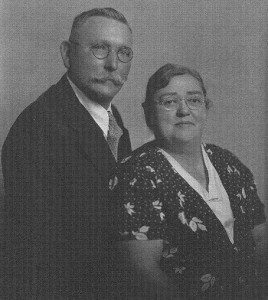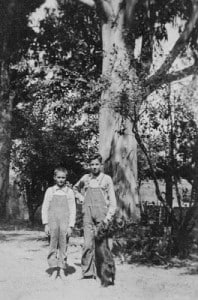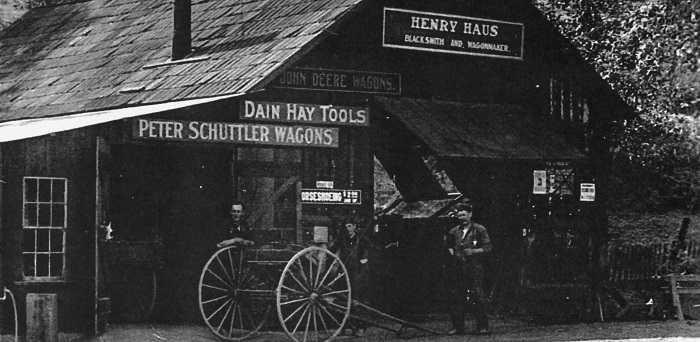People, Pope Valley
Pope Valley’s Blacksmith
by John Holt

Henry Haus came to the U.S. from Neftenbach, Switzerland, and settled in Pope Valley in the late 1880s. Henry, born in 1873, had an older brother named Ed who also immigrated to Pope Valley. The original blacksmith shop was built in 1890 by a man named McDonald and Henry, at the age of sixteen, went to work for him doing odd jobs and learning the trade. By 1897 MacDonald had gotten a bad case of “gold fever” and wanted to start prospecting so offered the shop to Henry. At seventeen Henry became a full-fledged blacksmith and owned his own shop.
In 1886 Henry’s eldest brother, Ed, married Bertha Leimbacher, a girl he had gone to school with, and in 1899 Henry wed Bertha’s youngest sister Anna Regula. Henry and Anna made their home near the shop and produced a family of four boys: George, Henry, Ernest, and Herman. Only George was known to have worked for any length of time at the blacksmith shop. Henry ran his shop essentially by himself from the time he bought it in 1897 until he retired in 1950.
By 1900 the blacksmith shop then had two farriers and a wagonmaker. As business flourished Henry worked the shop by day and kept the books at night and on Sunday. Initially powered by waterwheel, Henry added a mile long water pine line to the house. Word spread and soon his neighbors were asking him to pipe their homes, and Henry decided to sell water from his new pipe company. Those additional funds allowed him to expand to the front and back of the shop.
In 1910, Henry invented a shearing machine for cutting the ends off a horseshoe instead of cutting them with the anvil’s hardy, a square hole in top of anvil. The shearing machine patent was granted in 1919. Henry also owned the patent – one of seven patents in total – for what he called “attachable drill bits” used to drill mine shafts and holes for dynamite.
Henry’s businesses thrived until the introduction of the automobile. The shift to more cars and fewer wagons, a surplus in new machinery as a result of World War I manufacturing, and a change in attitude for buying new instead of fixing up old vehicles seriously decreased the need for many of the blacksmith’s services. Subsequent to the popularity of the automobile, tractors were rapidly replacing horses and mules. Henry kept the shop open with odd manufacturing and repair, but had to supplement his income by raising chickens and planting a walnut orchard. He even sold grapes sold to his brother Ed’s winery.

While all of Henry’s boys undoubtedly helped out at the blacksmith shop, none chose blacksmithing as a profession. George, the oldest and Herman, the youngest, became butchers, and Herman moved back to the Pope Valley area to buy and operate the St. Helena Meat Market from 1955-1970. Although Henry officially retired in 1950 he kept busy in and around the shop until his failing health and death in 1955 closed it for good.
Within a year after both parents passed away, Herman moved back into the old Haus home and occasionally used the blacksmith shop to repair and keep up the water supply pipe Henry had built for himself and his nearby Pope Valley residents.
On December 31, 1984, Herman deeded the old blacksmith shop to Napa County Historical Society upon the “condition that the said property be used solely and perpetually for the purpose of historical preservation of the blacksmith shop located thereon” (AP No. 18-100-05). NCHS maintains the shop in its original condition while opening it to the public at least once a year for historical tours or demonstrations.
This post is the first of a two-part series highlighting the Haus Blacksmith Shop in Pope Valley. The series is part of the 2016 Napa Valley History Tour.
Bibliography
Herman Haus grant deed (AO No. 18-100-05) recorded 12/31/1984.
“A World of Tools in One Museum,” Anvil Magazine, Dec. 2001.
“Henry Haus Blacksmith & Wagonmaker,” Dan Grigsby, NCHS summary, 1978.
“Keeping Tradition in Napa Valley,” NV Register, 1/7/1972.
“Tools That Made Our World,” www.antiquetools.com, 1999 01 Inc. NYC.
“The Wheelwrights Shop,” George Sturt, Cambridge U. Press, 1923+.
“Pope Valley Blacksmith Shop Opens the on the Past,” NV Register, 4/24/2008


